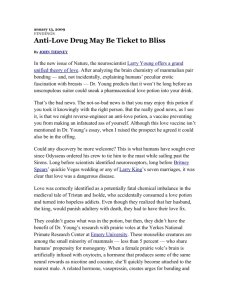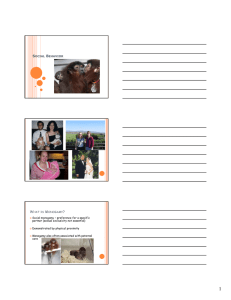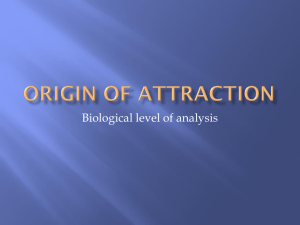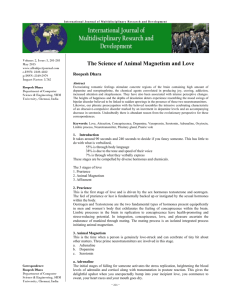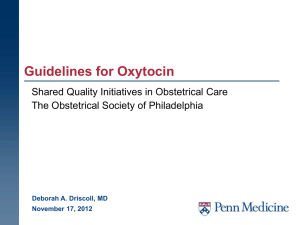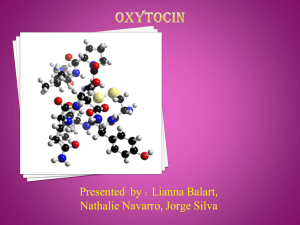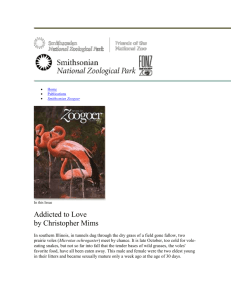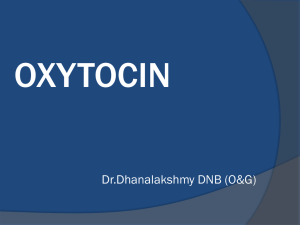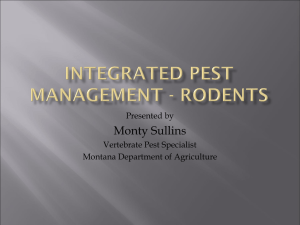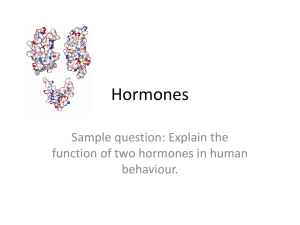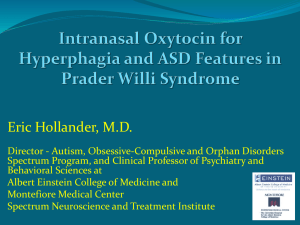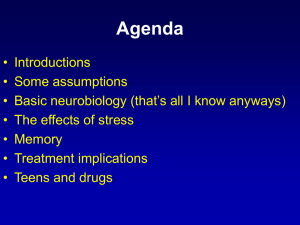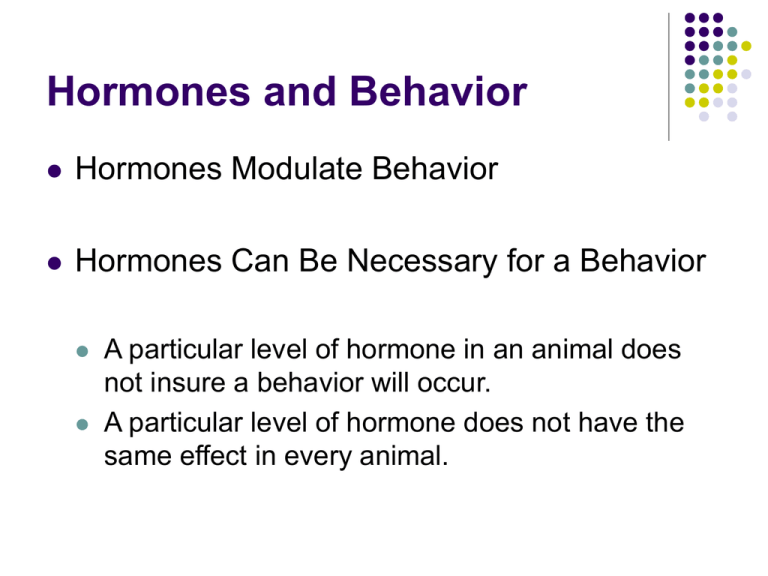
Hormones and Behavior
Hormones Modulate Behavior
Hormones Can Be Necessary for a Behavior
A particular level of hormone in an animal does
not insure a behavior will occur.
A particular level of hormone does not have the
same effect in every animal.
Hormones
Environment
Nervous System
Social Behavior and
Neuropeptides
Oxytocin (OT) and Vasopressin (AVP)
Influence a number of social behaviors including
Pair bonding
Maternal behavior
Affiliative behaviors
Generosity (?)
Promiscuity (?)
Where do they come from and how do they affect
the nervous system?
Hypothalamus
Hypothalamus
Preoptic
Supraoptic
Tuberal
Mammillary
Oxytocin and Vasopressin
Neurons - Production
Oxytocin and Vasopressin can be released
directly circulation and directly into the brain
Peripheral versus Central release
OT and AVP receptors are localized in the
limbic system
Oxytocin and Vasopressin
Behavioral Effects
Animal Models – Prairie Vole
California mouse
(Peromyscus californicus)
Voles: A Comparative Model
Voles: A Comparative Model
Prairie Voles
Biparental
Monogamous
Mating induces changes in the brain, partner
preference
Meadow and Montane Voles
Uniparental
Polygynous
Voles: A Comparative Model
Prairie Voles
OT – females
Facilitates maternal behaviors
Facilitates pair bond formations
AVP – males
Changes (cellular content/ immunoreactivity) with
parental experience and cohabitation
Facilitates pair bond formations and parental
experience
Site specific
AVP in the Brain (Lateral Septum) with
Parental Experience
Prairie and Meadow Voles
Males and Females
Parental or Naive
AVP and Prairie Voles
AVP and paternal
responsiveness in
male voles
Vasopressin Receptor: V1a
Is the V1a receptor necessary for social
behaviors?
Prairie Voles
AVP Receptor Pattern
Vasopressin Receptor Distribution varies
between Prairie and Montane Voles.
Montane pattern is more “typical” of other
rodent species, perhaps other mammals.
Vasopressin Receptor, V1a
Montane
Prairie
Staining (Autoradiography)
for Vasopressin Receptor
Vasopressin Receptor V1a
What happens if you experimentally make a
mouse brain like a vole brain for AVP?
Prairie Voles
Mice
Oxytocin and Vasopressin in
Humans
Several recent studies have begun to show
similar roles for these neuropeptides in
human behavior
Limbic system – evolutionary conservation
Vasopressin
Gene sequences on alleles may predict behavior
AVPR1a – Gene that codes for vasopressin receptor
Longer alleles (repeat of sequence) more monogamous
behavior – voles
Similar sequence may predict success of opposite success
relationships in humans (Walum et al., 2008)
Altruistic behavior – more money is given to other
participant
Vasopressin and Social Behavior
Intranasal Vasopressin in Men
Stimulates antagonist facial motor patterns to
unfamiliar faces, decreases perception of
friendliness
Intranasal Vasopressin in Women
Stimulates affiliative facial motor patters and
increases perception of friendliness
Oxytocin and Social Behaviors
Oxytocin can be released during social interactions
pair bonding and sex
mother – infant bonding
Birth – uterine contractions
Suckling - lactation
Oxytocin is measured in the blood
Oxytocin is also likely released in the brain
Oxytocin and Trust
Oxytocin can influence Trust
Trust game and monetary exchanges
Oxytocin levels are higher when individuals perceive
intentional trust.
Oxytocin ‘correlates’ with level of perceived trust
Pre- and post- measures
Correlation versus causation
Oxytocin and Trust
Fig. 2. OT levels and standards errors for DM2s with and without an
intention to trust. In the Intention condition, DM1s voluntarily transfer
money to DM2s. In the Random Draw condition, the transfer from DM1s to
DM2s was determined by a public draw of a numbered ball. OT levels
across conditions are statistically different at P < 0.05.
P.J. Zak et al. / Hormones and Behavior 48 (2005) 522–527
Oxytocin and Trust
Intranasal oxytocin can influence generosity/
trust
Intranasal OT and neural sites
Oxytocin and Trust
Figure 2 | Transfers in the trust and the risk experiment. Each observation
represents the average transfer amount (in MU) over four transfer decisions
per investor. a, Relative frequency of investors’ average transfers in oxytocin
(filled bars) and placebo (open bars) groups in the trust experiment
(n ¼ 58). Subjects given oxytocin show significantly higher transfer levels.
Oxytocin and Trust
Intranasal OT increases perception of facial
attractiveness, and trustworthiness
Oxytocin
Gene sequences on alleles may predict
behavior
OXTR
Specific sequence may predict altruistic behavior
and higher social values orientation
OT/AVP Implications
Patterns in the AVP and OT receptor gene
sequence may predict autism spectrum
disorders.
AVP and OT operate in similar ways in all
vertebrates that have been studied.
A mechanism for empathy in humans?

